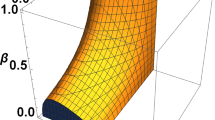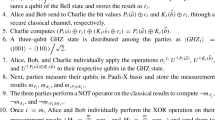Abstract
Nonlocality inequalities for multi-party systems act as contextuality inequalities for single qudit systems of suitable dimensions (Heywood and Redhead in Found Phys 13(5):481–499, 1983; Abramsky and Brandenburger in New J Phys 13(11):113036, 2011). In this paper, we propose the procedure for adaptation of nonlocality-based quantum conferencing protocols (NQCPs) to contextuality-based QCPs (CQCPs). Unlike the NQCPs, the CQCPs do not involve nonlocal states. As an illustration of the procedure, we present a QCP based on Mermin’s contextuality inequality. As a significant improvement, we propose a QCP based on CHSH contextuality inequality involving only four-dimensional states irrespective of the number of parties sharing the key. The key generation rate of the latter is twice that of the former. Although CQCPs allow for an eavesdropping attack which has no analog in NQCPs, a way out of this attack is demonstrated. Finally, we examine the feasibility of experimental implementation of these protocols with orbital angular momentum states.












Similar content being viewed by others
Notes
For higher number of parties, calculations are not difficult, but become tedious. Hence, the choice of three Bobs.
References
Grover, L.K.: Quantum mechanics helps in searching for a needle in a haystack. Phys. Rev. Lett. 79, 325–328 (1997)
Deutsch, D., Jozsa, R.: Rapid solution of problems by quantum computation. Proc. Math. Phys. Eng. Sci. 439(1907), 553–558 (1992)
Bennett, C.H., Wiesner, S.J.: Communication via one- and two-particle operators on Einstein–Podolsky–Rosen states. Phys. Rev. Lett. 69, 2881–2884 (1992)
Bennett, C.H., Brassard, G., Crépeau, C., Jozsa, R., Peres, A., Wootters, W.K.: Teleporting an unknown quantum state via dual classical and Einstein–Podolsky–Rosen channels. Phys. Rev. Lett. 70, 1895–1899 (1993)
Bennett,C., Brassard,G.: Quantum cryptography: public key distribution and coin tossing. Proc. IEEE Int. Conf. on Comp. Sys. Signal Process (ICCSSP), page 175, (1984)
Ekert, Artur K.: Quantum cryptography based on Bell’s theorem. Phys. Rev. Lett. 67, 661–663 (1991)
Namkung, M., Kwon, Y.: Generalized sequential state discrimination for multiparty qkd and its optical implementation. Sci. Rep. 10(1), 1–35 (2020)
Wootters, W.K., Zurek, W.H.: A single quantum cannot be cloned. Nature 299(5886), 802–803 (1982)
Vazirani, U., Vidick, T.s,: Fully device-independent quantum key distribution. Phys. Rev. Lett. 113, 140501 (2014)
Xiaolong, S.: Applying gaussian quantum discord to quantum key distribution. Chin. Sci. Bull. 59(11), 1083–1090 (2014)
Pirandola, S.: Quantum discord as a resource for quantum cryptography. Sci. Rep. 4, 6956 (2014)
Troupe, J.E., Farinholt, J.M.: A contextuality based quantum key distribution protocol. arxiv (2015)
Singh, Jaskaran, Bharti, Kishor, Arvind: Quantum key distribution protocol based on contextuality monogamy. Phys. Rev. A 95, 062333 (2017)
Nagata, K.: Kochen–Specker theorem as a precondition for secure quantum key distribution. Phys. Rev. A 72, 012325 (2005)
Heywood, P., Redhead, M.L.G.: Nonlocality and the Kochen–Specker paradox. Found. Phys. 13(5), 481–499 (1983)
David Mermin, N.: Simple unified form for the major no-hidden-variables theorems. Phys. Rev. Lett. 65, 3373–3376 (1990)
Gühne, O., Kleinmann, M., Cabello, A., Larsson, J., Kirchmair, G., Zähringer, F., Gerritsma, R., Roos, C.F.: Compatibility and noncontextuality for sequential measurements. Phys. Rev. A 81, 022121 (2010)
Abramsky, S., Brandenburger, A.: The sheaf-theoretic structure of non-locality and contextuality. New J. Phys. 13(11), 113036 (2011)
Beijersbergen, M.W., Coerwinkel, R.P.C., Kristensen, M., Woerdman, J.P.: Helical-wavefront laser beams produced with a spiral phaseplate. Opt. Commun. 112(5–6), 321–327 (1994)
Heckenberg, N.R., McDuff, R., Smith, C.P., White, A.G.: Generation of optical phase singularities by computer-generated holograms. Opt. Lett. 17(3), 221–223 (1992)
Mair, A., Vaziri, A., Weihs, G., Zeilinger, A.: Entanglement of the orbital angular momentum states of photons. Nature 412, 313 (2001)
Leach, J., Padgett, M.J., Barnett, S.M., Franke-Arnold, S., Courtial, J.: Measuring the orbital angular momentum of a single photon. Phys. Rev. Lett. 88(25), 257901 (2002)
Gregorius, C.G.B., Martin, P.J.L., Johannes, C., Marco, W.B., Miles, J.P.: Efficient sorting of orbital angular momentum states of light. Phys. Rev. Lett. 105(15), 153601 (2010)
Dada, A.C., et al.: Experimental high-dimensional two-photon entanglement and violations of generalized bell inequalities. Nat. Phys. 7, 677 (2011)
Fickler, R., Lapkiewicz, R., Plick, W., Krenn, C., Schaeff, M., Ramelow, S., Zeilinger, A.: Quantum entanglement of high angular momenta. Science 338, 640 (2012)
Malik, M., Mirhosseini, M., Lavery, M.P.J., Leach, J., Padgett, M.J., Boyd, R.W.: Direct measurement of a 27-dimensional orbital-angular-momentum state vector. Nature Commun. 5(1), 1–7 (2014)
Zhou, Z.-Y., Li, Y., Ding, D.-S., Zhang, W., Shi, S., Shi, B.-S., Guo, G.-C.: Orbital angular momentum photonic quantum interface. Light: Sci. Appl. 5(1), e16019–e16019 (2016)
Yin, J., Cao, Y., Li, Y.-H., Liao, S.-K., Zhang, L., Ren, J.-G., Cai, W.-Q., Liu, W.-Y., Li, B., Dai, H., et al.: Satellite-based entanglement distribution over 1200 kilometers. Science 356(6343), 1140–1144 (2017)
Erhard, M., Fickler, R., Krenn, M., Zeilinger, A.: Twisted photons: new quantum perspectives in high dimensions. Light: Sci. Appl. 7(3), 17146 (2018)
Clauser, J.F., Horne, M.A., Shimony, A., Holt, R.A.: Proposed experiment to test local hidden-variable theories. Phys. Rev. Lett. 23(15), 880 (1969)
Brunner, N., Cavalcanti, D., Pironio, S., Scarani, V., Wehner, S.: Bell nonlocality. Rev. Mod. Phys. 86, 419–478 (2014)
Jo, Y., Son, W.: Semi-device-independent multiparty quantum key distribution in the asymptotic limit. OSA Continuum 2(3), 814–826 (2019)
Allen, L., Beijersbergen, M.W., Spreeuw, R.J.C., Woerdman, J.P.: Orbital angular momentum of light and the transformation of laguerre-gaussian laser modes. Phys. Rev. A 45, 8185–8189 (1992)
Allen, L., Padgett, M.: Chapter 1–introduction to phase-structured electromagnetic waves. In: David, L., Andrews, W.S. (eds.) Structured Light and Its Applications, pp. 1–17. Academic Press, Burlington (2008)
O’Neil, A.T., Courtial, J.: Mode transformations in terms of the constituent Hermite-Gaussian or Laguerre-Gaussian modes and the variable-phase mode converter. Opt. Commun. 181(1–3), 35–45 (2000)
Mirhosseini, M., Malik, M., Shi, Z., Boyd, R.W.: Efficient separation of the orbital angular momentum eigenstates of light. Nature Commun. 4(1), 1–6 (2013)
Vaziri, A., Weihs, G., Zeilinger, A.: Superpositions of the orbital angular momentum for applications in quantum experiments. J. Opt. B: Quantum Semiclass. Opt. 4(2), S47 (2002)
Sroor, H., Huang, Y.-W., Sephton, B., Naidoo, D., Vallés, A., Ginis, V., Qiu, C.-W.: Antonio Ambrosio, Federico Capasso, and Andrew Forbes. High-purity orbital angular momentum states from a visible metasurface laser. Nature Photon. (2020)
Proietti, M., Ho, J., Grasselli, F., Barrow, P., Malik, M., Fedrizzi, A.: Experimental quantum conference key agreement. Sci. Adv. 7(23):eabe0395, eabe0395 (2021)
Leach, J., Courtial, J., Skeldon, K., Barnett, S.M., Franke-Arnold, S., Padgett, M.J.: Interferometric methods to measure orbital and spin, or the total angular momentum of a single photon. Phys. Rev. Lett. 92(1), 013601 (2004)
Wang, Y., Potoček, V., Barnett, S.M.: Feng, X: Programmable holographic technique for implementing unitary and nonunitary transformations. Phys. Rev. A 95, 033827 (2017)
Scarani, V., Bechmann-Pasquinucci, H., Cerf, N.J., Dušek, M., Lütkenhaus, N., Peev, M.: The security of practical quantum key distribution. Rev. Mod. Phys. 81(3), 1301 (2009)
Mermin, N.D.: Extreme quantum entanglement in a superposition of macroscopically distinct states. Phys. Rev. Lett. 65, 1838–1840 (1990)
Acknowledgements
The authors would like to thank the anonymous reviewers for their valuable comments that help enhancing the quality of the paper. Rajni thanks UGC for funding her research. Sooryansh thanks the Council for Scientific and Industrial Research (Grant no. -09/086 (1278)/2017-EMR-I) for funding his research.
Author information
Authors and Affiliations
Contributions
All the authors contributed equally in all respects.
Corresponding author
Additional information
Publisher's Note
Springer Nature remains neutral with regard to jurisdictional claims in published maps and institutional affiliations.
Appendices
A Mermin’s nonlocality inequality as contextuality inequality
The interrelation between the two-party nonlocality and single-qudit contextuality, shown in Sect. 3.1 for CHSH inequality, continues to hold even for multi-party nonlocality inequalities. We illustrate it through the example of Mermin’s inequality. For that, we briefly recapitulate Mermin’s inequality for an N-party system.
Mermin’s inequality distinguishes the states admitting completely factorisable local hidden variable model from nonlocal states.
Consider a pair of dichotomic observables \(\{A_{j}, A'_{j} \}\) in the space of the \(j^\mathrm{th}\) party (\( j\in \{1, \cdots , N\}\)). The inequality is as follows [43]:
The observables corresponding to different parties commute and \([A_k,A'_k] \ne 0\).
For the special case of an N qubit system, inequality (39) gets maximally violated by the GHZ state,
for the following choice of the observables:
It is pertinent to illustrate the contextual behaviour of \(|\phi _N\rangle \) to substantiate our claim. For that purpose, we consider the following two contexts: Context 1 (\(Z_1 Z_2\cdots Z_{N-1}Z_N \)): Suppose the outcome of \(Z_1\) is \(+1(-1)\). Then, the outcomes of observables \(Z_2, Z_3, \cdots , Z_N\) will be \(+1(-1)\) with unit probability. Context 2 (\(Y_1Z_2\cdots Z_N\)): Let the outcome of the measurement of \(Y_1\) be once again, +1. Following it, the measurement of observable \(Z_2\) will yield \(+1\) or \(-1\) with equal probability. Thereafter, the measurement of \(Z_3, \cdots , Z_N\) will definitely yield +1. Thus, the outcome of \(Z_2\) depends on the set of commuting observables it is measured with, i.e. it depends on the context. Exactly in the same manner as in Sect. 3.1, the observables and the state in the \(2^N\) dimensional Hilbert space can be identified.
The equivalent observables \(\{{\mathbb {Z}}_1,\cdots , {\mathbb {Z}}_N,{\mathbb {Y}}_1 \}\) can be obtained by following the prescription in point (2) and (3) of Sect. 2, and they satisfy the same commutation relations as \(\{{Z}_1,\cdots , {Z}_N, {Y}_1 \}\) because of operator isomorphism. Thus, Mermin’s inequality probes contextuality in a qudit of appropriate higher dimension and can be referred to as Mermin’s contextuality inequality.
B Illustration of eavesdropping
To illustrate the point that how Eve obtains information about the key without disturbing the violation of contextuality inequality, we consider the QCP based on Mermin’s contextuality inequality. Consider an example of three parties, Bob\(_1\), Bob\(_2\) and Bob\(_3\). We choose following set of observables:
where the symbols \(|l^{\pm }\rangle \) are defined as,
Consider the following two situations, one in which there is no eavesdropping, the other in which Eve is present.
-
1.
Case I: Following the steps of Mermin’s contextuality-based QCP, let Bob\(_1\) prepares a state \(|\Psi _M'\rangle =|0\rangle \) for the +1 outcome of \({\mathbb {Z}}_1\) on the reference state \(|\Psi _M\rangle \). He sends this state \(|\Psi _M'\rangle \) to Bob\(_2\). If Bob\(_2\) measures, say, \({\mathbb {Z}}_2\) on this state, he obtains the outcome +1 with unit probability. Thereafter, he sends the post-measurement state to Bob\(_3\). Bob\(_3\) measures, say, \({\mathbb {Z}}_3\), he is bound to get outcome +1 with unit probability.
-
2.
Case II: Let there be an eavesdropping between Bob\(_2\) and Bob\(_3\). Eve measures an observable, \(\mathbb {X_1}\). She obtains \(\pm 1\) with equal probability and the state collapses to \(|\Phi ^{\pm }\rangle =\frac{1}{\sqrt{2}}(|0\rangle \pm |4\rangle )\). She sends the post-measurement state to Bob\(_3\). Bob\(_3\) measures an observable \({\mathbb {Z}}_3\), as in the previous case, and obtains outcome +1 with unit probability. Thus, the measurement of Eve does not affect the outcome of Bob\(_3\)’s measurement. Due to this, Bob\(_3\) will never detect presence of Eve. In this way, Eve can obtain full information about the key by choosing appropriate observable without being detected.
Rights and permissions
About this article
Cite this article
Bala, R., Asthana, S. & Ravishankar, V. Contextuality-based quantum conferencing. Quantum Inf Process 20, 352 (2021). https://doi.org/10.1007/s11128-021-03286-8
Received:
Accepted:
Published:
DOI: https://doi.org/10.1007/s11128-021-03286-8




